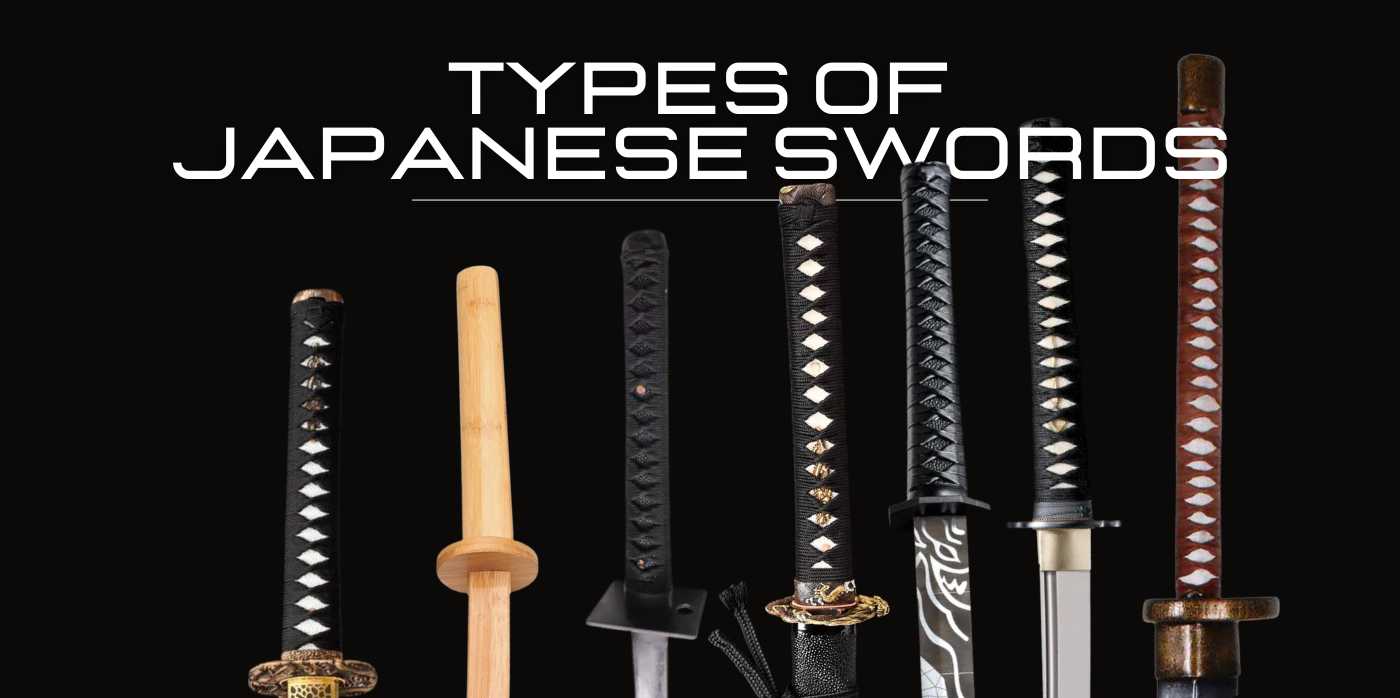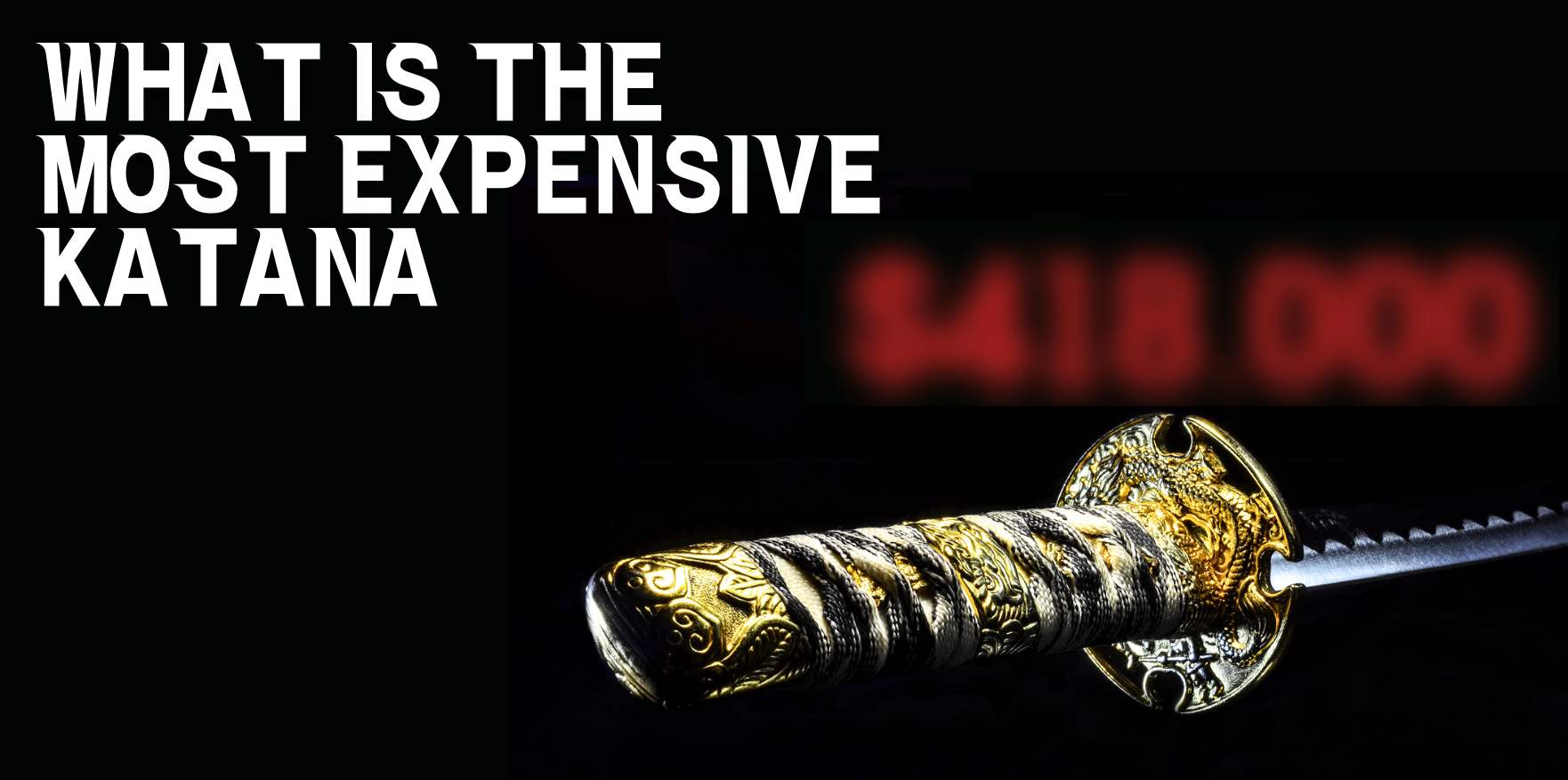Japan, the country of the rising sun, has a long and colorful history that is firmly anchored in martial arts customs. Central to these traditions are the Japanese swords. While the Katana may be the most famous among them, there is an array of other swords, each with unique characteristics and histories. In this blog post we will discover all the types of Japanese swords, taking you on a journey through the annals of Japan’s martial history.
1. Different Types of Japanese Swords
1.1 Katana
The Katana, the most iconic and well-known type of Japanese sword, became prominent in the Kamakura period (1185–1333). Katanas are characterized by their curved, single-edged blade, circular or squared guard, and long grip to accommodate two hands. The blade is usually about 60-80 cm in length.
- Period: Kamakura Period
- Length: 60-80 cm
- Key Characteristics: Curved, single-edged blade; long grip
- Shape: Slight curve
- Kanji: 刀

1.2 Tachi
The Tachi predates the katana and was widely used in the Heian period (794 to 1185). Tachis are generally longer than katanas, with a highly curved blade designed for mounted combat. The Tachi was worn hanging from the belt with the edge facing down, differentiating it from the Katana.
- Period: Heian Period
- Length: 70-80 cm
- Key Characteristics: Highly curved, designed for mounted combat
- Shape: Significant curve
- Kanji: 太刀

1.3 Kodachi
The Kodachi, or 'small Tachi,' was used during the Kamakura period. It's shorter than a Tachi but longer than a Tanto, typically with a length between 60 cm to 65 cm. These swords were used as secondary weapons in close-quarter combat.
- Period: Kamakura Period
- Length: 60-65 cm
- Key Characteristics: Short, used for close combat
- Shape: Slight curve
- Kanji: 小太刀``

1.4 Odachi / Nodachi
The Odachi or Nodachi are exceptionally large swords, typically exceeding 100 cm. They were used in the late Kamakura period (1333-1573) and were designed to be used on horseback or against cavalry units.
- Period: Late Kamakura Period
- Length: Above 100 cm
- Key Characteristics: Exceptionally long, used on horseback
- Shape: Significant curve
- Kanji: 大太刀

1.5 Wakizashi
The Wakizashi was used from the Muromachi period (1333–1573) and was the companion sword to the Katana, making up the Daisho, or the 'long and short.' The Wakizashi is shorter than a Katana, ranging from 30 to 60 cm, and was used for indoor fighting, seppuku, or as a backup sword.
- Period: Muromachi Period
- Length: 30-60 cm
- Key Characteristics: Companion to Katana, used for indoor fighting
- Shape: Slight curve
- Kanji: 脇差

1.6 Tanto
During the Heian period, the Tanto, a knife or dagger with a short blade measuring between 15 and 30 cm, was quite common. It may be used for slicing but was usually employed as a stabbing tool.
- Period: Heian Period
- Length: 15-30 cm
- Key Characteristics: Dagger-like, used for stabbing
- Shape: Mostly straight
- Kanji: 短刀

1.7 Naginata
Between the 12th and the 14th centuries, samurai, monks, and foot troops frequently used the Naginata, a pole weapon. It features a long hardwood shaft that is finished with a curved blade.
- Period: Kamakura Period
- Length: Shaft and blade combined can reach 200 cm
- Key Characteristics: Pole weapon, used for keeping enemies at a distance
- Shape: Long shaft with a curved blade
- Kanji: 薙刀

1.8 Tsurugi
The Tsurugi or Ken is a double-edged sword that was commonly used before the Heian period. It is mostly associated with religious or ceremonial use, particularly Shinto rituals.
- Period: Before Heian Period
- Length: Varies widely
- Key Characteristics: Double-edged, used in Shinto rituals
- Shape: Straight
- Kanji: 剣

1.9 Shinobigatana
The Shinobigatana, sometimes referred to as the "ninja sword," is a single-edged, 60 cm long straight sword. It was utilized by the Shinobi, often known as ninjas, during the Sengoku era (1467–1615).
- Period: Sengoku Period
- Length: 60 cm
- Key Characteristics: Straight, single-edged, used by ninjas
- Shape: Straight
- Kanji: 忍者刀

1.10 Yoroi-dōshi
The Yoroi-dōshi is a type of Tanto designed for piercing armor. It's shorter and sturdier than a typical Tanto, with a blade length that can range from 20 to 22 cm.
- Period: Kamakura Period
- Length:20-22 cm
- Key Characteristics: Short and sturdy, used for piercing armor
- Shape: Mostly straight
- Kanji: 鎧通し

1.11 Chokutō
One of the earliest varieties of swords in Japan is the Chokuto, which dates to the Nara era (710–794).
- Period: Nara Period
- Length: 65-76 cm
- Key Characteristics: Straight, single-edged blade
- Shape: Straight
- Kanji: 直刀

1.12 Nagamaki
The Nagamaki, which translates to "long wrap", is a type of traditionally made Japanese sword with an extra-long handle. It was used from the Kamakura to the Muromachi period.
- Period: Kamakura to Muromachi Period
- Length: Total length up to 200 cm, blade length about 60-80 cm
- Key Characteristics: Long handle for two-handed use
- Shape: Significant curve
- Kanji: 長巻

1.13 Bokken
Even though the bokken (wooden sword) lacks a genuine steel blade, it is nonetheless used in training as a Japanese sword. Despite having a Katana-like shape, it is made of wood and is not lethal.
- Period: Used throughout Japanese history for training
- Length: Same as Katana, around 60-80 cm
- Key Characteristics: Wooden, used for training and kata
- Shape: Slight curve
- Kanji: 木剣

1.14 Uchigatana
The Uchigatana is the predecessor to the modern Katana, popular during the Muromachi period. It was a weapon designed for one-on-one combat on foot, held with the cutting edge facing upwards.
- Period: Muromachi Period
- Length: 60-80 cm
- Key Characteristics: Designed for infantry combat, cutting edge up
- Shape: Slight curve
- Kanji: 打刀

1.15 Yari
The Yari is a traditional Japanese spear, or more accurately, a thrusting weapon. They were very popular because of their long reach and ease of production compared to swords.
- Period: Feudal Japan, especially Sengoku Period
- Length: Varies widely from 30 cm to 6 meters, with 2-3 meters being common
- Key Characteristics: Thrusting weapon, long reach
- Shape: Long shaft with straight spear point
- Kanji: 槍

2. Japanese swords classification by period
In the Nara Period (710-794), the straight, single-edged Chokutō was prevalent. This period was marked by the development of the Ritsuryō system, a legal and governmental structure modeled after Chinese Tang Dynasty.
The Heian Period (794 to 1185) witnessed the rise of the Tachi and the Tanto. The supremacy of the Fujiwara clan and the growing influence of Buddhism marked this period as one of considerable cultural and aesthetic advancement.
Several sword styles gained popularity during the Kamakura Period (1185–1333), when the samurai class attained political power, including the Wakizashi, Kodachi, and Nagamaki. In the Kamakura era, a feudal military administration was established with a focus on martial arts.
The Muromachi Period (1336-1573) saw the emergence of the Uchigatana and the Odachi, reflecting the shift in warfare strategies and infantry tactics. The Ashikaga shogunate ruled during this period, known for the Ōnin War and the ensuing Sengoku ('Warring States') period.
The Katana became the most common form of sword throughout the Azuchi-Momoyama Period (1573–1603) and the Edo Period (1603–1868), denoting the dignity of the samurai. The Tokugawa shogunate's unification of Japan during these times brought to a protracted period of calm, isolation, and rigorous social order.
Swords like the Bokken and Yari have been used throughout these periods for different purposes, like training and battlefield use. Whether it's the simplicity of the Bokken or the practicality of the Yari, these swords provide insights into the multifaceted aspects of Japanese martial culture.
Conclusion
Understanding the variety of Japanese swords offers fascinating insights into the evolution of Japan's military history, societal values, and cultural aesthetics. Each type of sword, from the iconic Katana to the humble Bokken, carries a unique story of the samurai, the Japanese warrior class. The beauty, sharpness, and precision of these swords are testaments to the Japanese blacksmith's extraordinary skill and the samurai's martial prowess. From the battlefield to the training dojo, these swords are symbols of the Samurai's Bushido: their way of the warrior.



